Low reproductive success in a colony of Black-headed Gulls Larus ridibundus—mass starvation of nestlings?
DOI:
https://doi.org/10.34080/os.v2.23052Keywords:
population studies, breeding success, breeding biology, threatsAbstract
The Black-headed Gull Larus ridibundus has declined in Sweden during the last twenty years, locally with as much as 75%. The factors causing this decline are unknown, and we lack data on reproductive success and mortality. In 1992, I recorded breeding success of a colony of 818 pairs on Lilla Karlso in the Baltic Sea. Only 0.37 fledglings per pair were produced. No predation was observed. When the surviving young had left the colony a search revealed at least 151 dead young (>14 days old). Five of them were recently dead. They were very thin with atrophied pectoral muscles, indicating starvation as the cause of death. The reproductive rate that I observed is lower than in other European studies, but similar to the one found in a declining colony in Britain. May and June of 1992 were very dry, possibly making the main food, earth worms, unavailable. Hence, 0.37 young per pair may not be typical for an average weather situation. None the less, it is urgent to carry out further studies on the breeding success of the Black-headed Gull in the Nordic and Baltic countries in order to determine whether starvation or any other factor contributes to the population decline of the species.
Downloads

Downloads
Published
How to Cite
Issue
Section
License
The copyright of each contribution belongs to the author(s), but all contributions are published under a Creative Commons license, so that anyone is free to share and reuse the contribution as long as the copyright holder is attributed.







